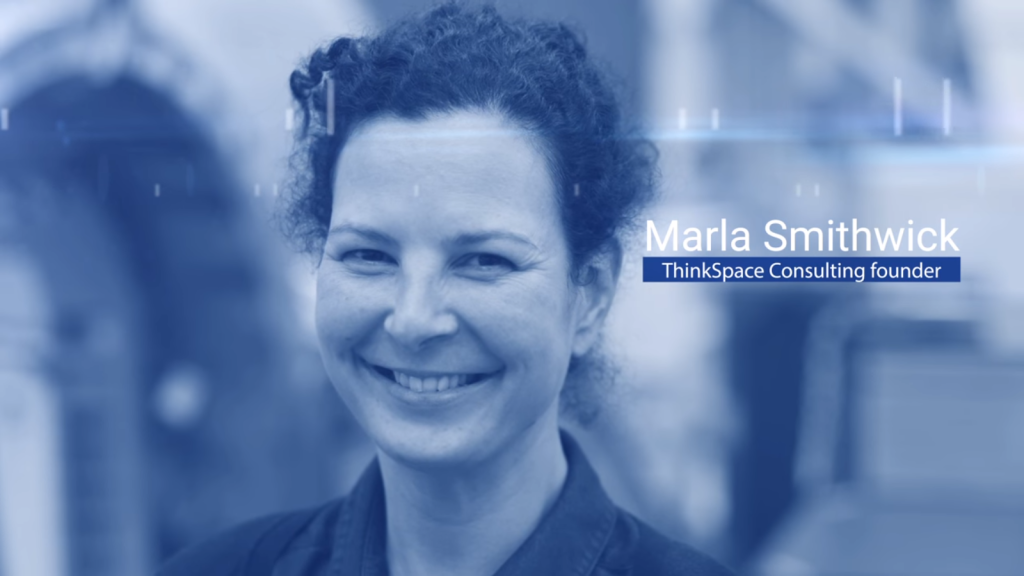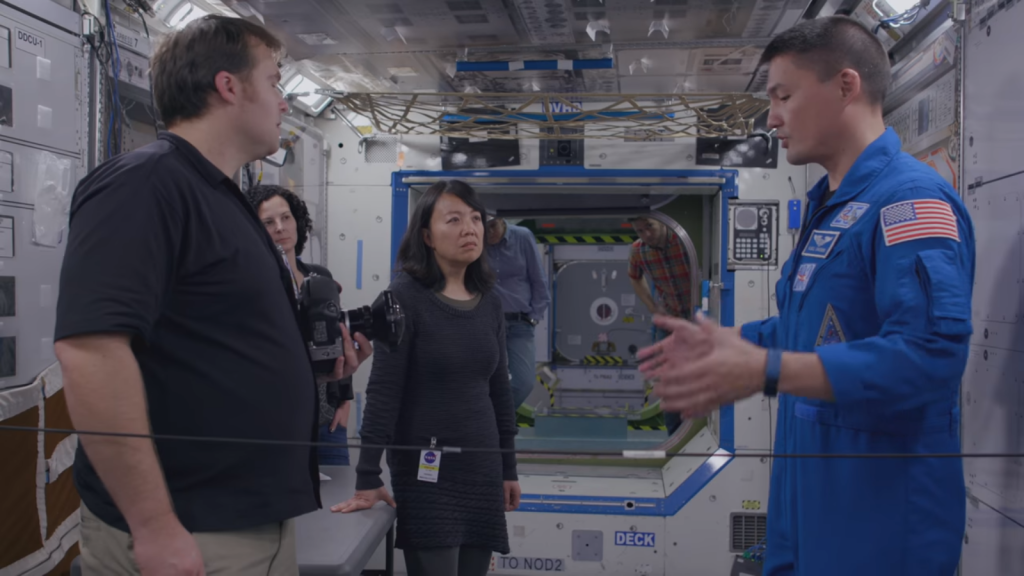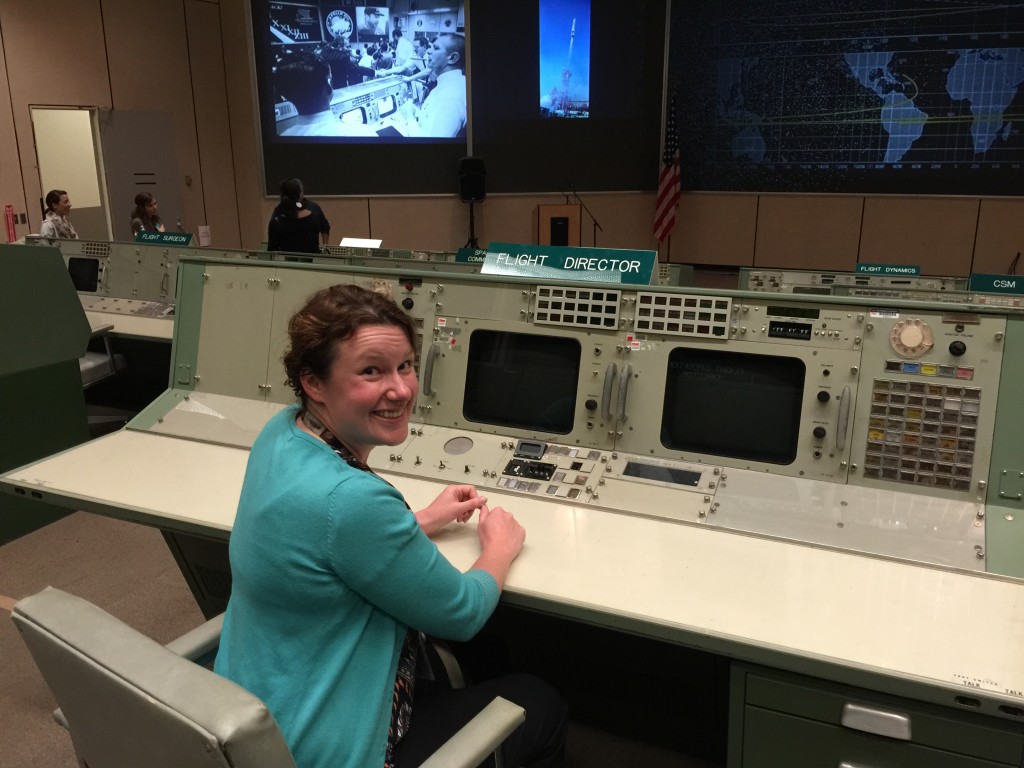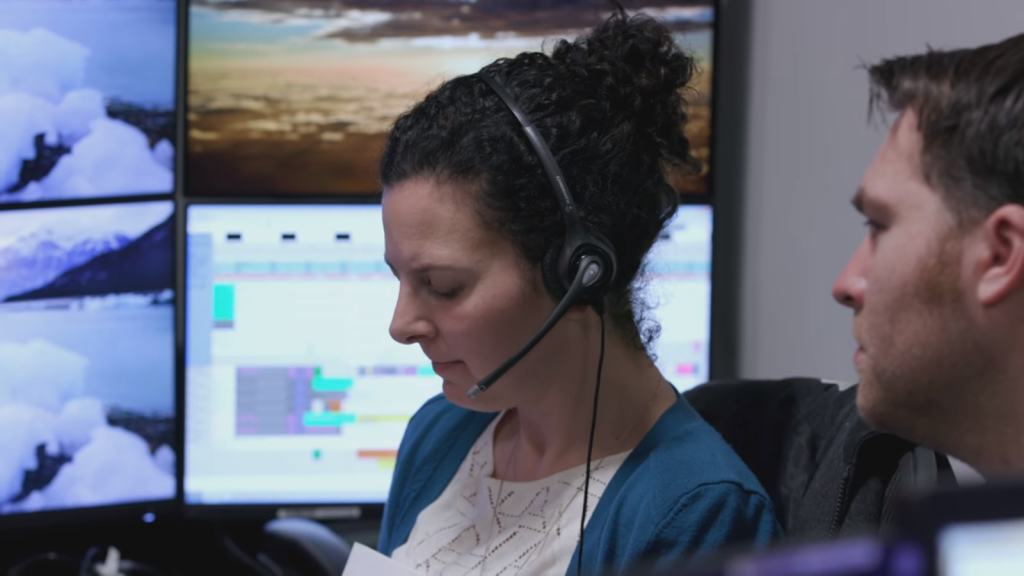The experience of floating through the International Space Station is no longer solely the privilege of astronauts. Now you can experience it too. Thanks to an ingenious and hardworking team of Rocket Women from ThinkSpace Consulting, along with Google, NASA and the European Space Agency (ESA), the International Space Station is now available to explore on Google Street View. Working with astronauts, the entire interior of the International Space Station was photographed and mapped, even bringing the stunning vistas from the Cupola module to your screen. The project impressively took four months to complete from start to finish. Comparatively, experiments that astronauts conduct onboard on the ISS have been planned for at least two years.
![The stunning views from the International Space Station's Cupola module [Still taken from Google StreetView]](https://rocket-women.com/wp-content/uploads/2017/08/ISS-Google-StreetView-Cupola-1024x491.png)

![Alice Liu - Google Street View [Still from Behind the Scenes: Mapping the International Space Station with Google Street View https://youtu.be/IBTP62jd4DA]](https://rocket-women.com/wp-content/uploads/2017/08/Alice-Liu-Google-Street-View-1024x576.png)
![Deanna Yick. Google Street View Program Manager [Still from Behind the Scenes: Mapping the International Space Station with Google Street View https://youtu.be/IBTP62jd4DA]](https://rocket-women.com/wp-content/uploads/2017/08/Deanna-Yick-Google-1024x576.png)

When you look down at the Earth you realize that it’s one big spaceship and if we don’t look after that spaceship, it won’t look after us. – NASA Astronaut Kjell Lindgren
The impressive project gives you a sense of the science and engineering it took to build the International Space Station’ with a volume of 5-bedroom house, or two 747s, and keep it running. As NASA Astronaut Kjell Lindgren describes in this video, the project also ‘gives you an idea of what is possible if countries come together to build a peaceful project on this scale and gives people an idea of the modules in the ISS, including the toilets.’ Based at NASA’s Marshall Spaceflight Center, the team scheduled a test, with ISS crewmember ESA Astronaut Thomas Pesquet taking photographs onboard the ISS.

It’s a fantastic opportunity for everyone to fly with the astronauts.
ThinkSpace Consulting Operations Engineer and Co-Founder Marla Smithwick, supported the activity ‘on-console’ by communicating with ESA Astronaut Thomas Pesquet onboard the ISS. Astronauts subsequently took images of all of the ISS modules, creating a comprehensive interior tour. As Marla describes, bungees and kapton tape were used to mark the middle of the ISS module and as a reference point to rotate the camera around. The original activity with Thomas Pesquet took the astronaut two and a half hours to take pictures of the space station. Astronauts are trained extensively in photography prior to their mission, and worked with the team to quickly overcome any problems in real time. The Google Street View ISS collection gives viewers a sense of what it’s like to live and work onboard the ISS, in addition to digitising the station for history. As mentioned by the Google Street View team, it’s a ‘fantastic opportunity for everyone to fly with the astronauts.’
ThinkSpace Consulting Co-Founders Marla Smithwick & Ann Kapusta talked to Rocket Women about the project and their role in its success!
How were you inspired to consider a career in the space industry?
Marla: I’m sure that most people will tell you that when they were a kid they thought space was cool, and I think I did too. But I wasn’t a big space geek and it was too out of reach for me to consider a career in it. Then when I was in Grade 7 I was selected to do some sort of space camp, where we spent a few days at the University of Saskatchewan learning about space, designing our own space station, and at the end we met Astronaut Marc Garneau. I realize that’s dating me a bit – but it was a big deal to twelve-year old me. Then in 2006 I met a Colonel who worked at the Canadian Space Agency (CSA) when I was doing a tour with the Canadian Navy. I realized that I wanted to work at the CSA more than any other job I could think of, so I immediately began hassling him for a job. About 6 months later he finally relented and arranged an interview. They offered to do it over the phone but I asked if it was okay if I made the six-hour drive to do it in person. I remember when I was walking up to the CSA for the interview I thought, “Well, even if I don’t get this job at least I got to go into the Canadian Space Agency on business once in my life”.

What sparked the idea to bring the International Space Station To Google Street View?
Marla: To be honest I don’t know! It was a great idea but it wasn’t mine. We were brought into the project by Google after they had tried to get it done and hadn’t gotten traction on their own. It was quite lucky for us and because we know the industry and what the issues were with their original proposal we were able to get it approved by CASIS with some fun add-ons like flight patches and crew member interviews.
Ann: The idea actually stemmed back in early 2015 from a good friend and old colleague of mine, Emma Lehman, who was working at Google and had met Alice Liu, the ISS Google Street View Program Manager. Emma, being a space fanatic like myself, got to talking with Alice about how amazing it would be to experience the ISS in full 360-degree panorama and get a feeling of floating through our incredible orbiting laboratory. Emma, knowing that Marla and I had just started ThinkSpace and knew we had the ability to make this pipe dream a reality, introduced Google Street View Special Collects to ThinkSpace and the rest is history.
There were two major challenges with this project that were incredibly intertwined – the project timeline and the international negotiations. Google had a strict timeline and after all proper contracts were in place, the timeline shrunk to a mere 4-months from project kick-off to full collection of all images on-board the ISS.
What were the biggest challenges during the project?
Marla: The timeline was very challenging, we were trying to meet a product launch date that was less than a year away. Most payloads take a minimum of two years of preparation time.
Ann: There were two major challenges with this project that were incredibly intertwined – the project timeline and the international negotiations. Google had a strict timeline and after all proper contracts were in place, the timeline shrunk to a mere 4-months from project kick-off to full collection of all images on-board the ISS. In this 4-month timeframe, ThinkSpace needed to act quickly to develop requirements, build crew procedures, gain permissions to hardware on-board, dry-run the procedures at Johnson Space Center ISS mock-up facility, specify crew time for project completion, obtain approval for flight products, among other logistics.
One of the key other logistics that ThinkSpace needed to coordinate and could make or break the success of the ISS Street View project, was to gain permission to image non-NASA built modules of the ISS. The ISS is made up of 16 modules built by a group of International partners and commercial companies including NASA, Roscosmos, JAXA, ESA, and Bigelow Airspace. In the end, we not only gained permission and enthusiastic collaboration from all International Partners to image the full ISS, but we also received permissions from private companies SpaceX and Orbital to image visiting vehicles and get an incredible comprehensive survey of life on the ISS. This was a huge challenge and a personal success for me in the project that we have a full and complete tour of the ISS for everyone to see.

Marla: We received approval from CASIS to do the project in October or November, and did the dry-run at JSC [NASA’s Johnson Spaceflight Center in Houston] in January and the on-orbit operations in February. Once we were approved we were off and running.
I have always had a courageous mind and sought opportunities to challenge myself and continue to learn, which ultimately has lead me in a chaotically consistent career journey. Consistency in that I have maintained focus on my passion for space, exploration, and innovation. Chaotic in the twists and turns I’ve taken while following my passion and desire to keep learning and pushing myself throughout my career.
Was there anything unexpected about your career journey that you thought would be different to your initial expectations?
Ann: I have always had a courageous mind and sought opportunities to challenge myself and continue to learn, which ultimately has lead me in a chaotically consistent career journey. Consistency in that I have maintained focus on my passion for space, exploration, and innovation. Chaotic in the twists and turns I’ve taken while following my passion and desire to keep learning and pushing myself throughout my career.
I started out a scientist, earning my degree in astrophysics. I studied cataclysmic binary variable stars at Kitt Peak Observatory and sought patterns in Ionspheric disturbances at the Haystack Observatory. The science was exciting but I always wanted to know the hows behind the data – so I transitioned to aerospace engineering. A pretty uncharacteristic move for a scientist. Utilizing my dual degree – I spent time in satellite data analysis, instrument calibration design and testing, and operations. Until I decided to take another courageous leap from satellites to a different world in space – human spaceflight. And even weirder, into designing and running a biological experiment in space – with no formal background in biology. And if that wasn’t enough organized chaos for my whole career, I recently took the most courageous leap of all and left Silicon Valley and aerospace to lead the R&D team at a digital innovation company, Vectorform, in Detroit. All while co-founding and running a space consulting company, ThinkSpace, in order to maintain a constant connection to my consistent lifelong passion of astronomy and space.
How did your family help to shape your career path in STEM?
Ann: My family has always been and continues to be a huge contributing factor in my career and lifelong interest in the STEM fields. My family not only exposed me to the wonders of science and engineering from an early age, but also gave me constant and unfailing encouragement to always follow my passion no matter what. I grew up in a family of engineers and machinists in the Western Pennsylvania rust belt, and was the second of two daughters. From as far back as I can remember, my parents and grandparents taught my sister and I how things worked and to always ask questions when we didn’t understand. They were tinkerers, so we became tinkerers. They were critical thinkers, so we became critical thinkers and problem solvers. They taught us to wonder when things didn’t make sense and to think beyond when things did.
My father taught me to program CAD models for lathes and mills in the early 90’s. I played with LEGO, Barbie, and all of the original NES Mario Brothers games. There was never a thing I “shouldn’t” be doing or “should” be doing when it came to learning, all that mattered is that I was exploring and asking questions. When I look back now, I think the main thing that my family did to help me find my career was provide me constant encouragement of personal exploration to find my passion and never discouragement of any path. It allowed me to find and follow my true passion.
![The ISS Google Street View Mission Patch [ThinkSpace/Google]](https://rocket-women.com/wp-content/uploads/2017/08/GoogleStreetView_MissionPatch-1024x1024.jpg)
Ann: Throughout my life I’ve wanted to be a lot of different things – from marine biologist to concert pianist to architect. I was always passionate about learning new things and each new thing opened up a new career opportunity. However, the more I journeyed through life, the more I looked to the stars and the more they inspired me. The ability to be part of a field so vast and so unknown, fuels my desire to always push what’s possible and to never stop learning throughout my life. Once I realized that the boundlessness of space mimicked my requirements for personal fulfillment, I knew astronomy was where I wanted to take my career.
What are you favourite things about your job?
Ann: My favorite thing about this career path and my job is the constant opportunity to learn and create something new. I have the ability to be innovative and solve problems in unique and new ways, and I have access to some incredibly smart people to inspire me, teach, and collaborate with. It is something that is so critically important to me – to do something I am passionate about, continue to learn, have the opportunity to be creative and innovative, and to make a difference. And I get to do all of those things in my job and I couldn’t be happier with my career choices.
Name the biggest overall lesson you’ve learned in running a business?
Marla: There are so many lessons. The biggest for me is appreciating the different mindset you have to be in when all of the responsibility is on you, and the amount you make is dependent on your ability to get business, negotiate and be efficient. And that percentage companies charge called “overhead” is totally legit.
I took a very meandering path to where I am but if I’m being honest with myself, the failures were just as important in contributing to the direction as the successes.
Is there a follow-up Google Street View project planned as the ISS expands or to incorporate commercial crew vehicles?
Marla: This time around we got the BEAM [Bigelow Expandable Activity Module], the SpaceX Dragon and the Cygnus vehicles so the cooperation from the commercial companies was fantastic. Once commercial crew vehicles are flying that would be a great follow-on project! We are discussing some other projects, some on the ISS and some not, but nothing is on paper as of yet.
If you had one piece of advice for your 10-year-old self, what would it be?
Marla: That’s tough because usually advice comes from things you feel like you could’ve done better. I took a very meandering path to where I am but if I’m being honest with myself, the failures were just as important in contributing to the direction as the successes. So maybe that’s the advice – don’t beat yourself up too badly for the failures, just try to learn from them and keep moving. Oh and I would like to tell my past self that at the end of my final exam in senior year of high school I really need to pick up my feet so I don’t trip and fall on my face in front of the whole class. That would’ve been nice to avoid.
Ann: Don’t be afraid. Don’t be afraid to try. Don’t be afraid to ask questions, even when they may seem dumb. Don’t be afraid to change your mind or your career or your path when you aren’t happy or fulfilled. Don’t be afraid to say “no” when something doesn’t feel right and don’t be afraid to stand up and say “yes” when you feel it. Don’t be afraid to stand alone (even though I know from experience that is incredibly scary). Don’t be afraid to stand up for yourself and what you believe in. Don’t be afraid to fail. Don’t be afraid to do something different. And don’t be afraid to be an inspiration to others.
This isn’t just advice that I would give to my 10-year-old self, but advice that I give to myself every day. In the career I chose and the path I am on, some days are still tough and some days are scary, but that comes with the territory of challenging yourself to so something new and incredible every single day.
Take a tour of the International Space Station on Google Street View and learn more about the project here.
